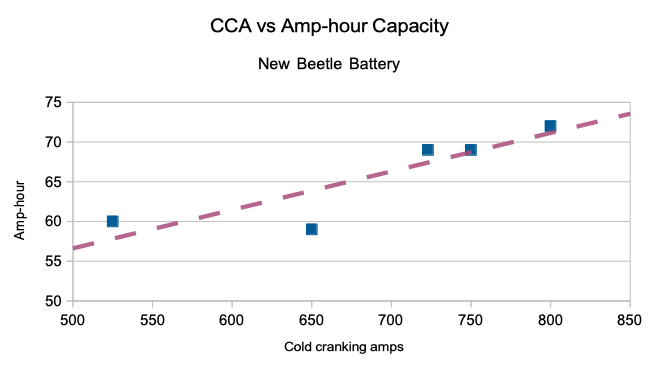Topics
Use this battery life calculator to estimate how long the Ute can be parked and still start the engine. See instructions below.
Background
If the Beetle Ute isn’t driven on a daily basis, or if it is stored for over a month, a battery current drain may discharge the battery completely. A small amount of current drain is normal to maintain Volkswagen’s security system, the radio settings, and a few other functions.
In our Ute, the drain is about 100 mA (0.1 amps) which is on the high side relative to some 2021 model cars. The length of time the battery can maintain enough capacity to start the engine depends on the amp-hour capacity, the average current drain level, and the battery’s level of charge at the beginning of the storage period.
The capacity of most New Beetle batteries is between 59 and 72 amp-hours. Manufacturers often define battery capacity based on cold cranking amps (CCA), but there isn’t a simple correlation between CCA and amp-hours.
Capacity and current drain measurement

Research the amp-hour capacity of the battery, or if not readily available, estimate amp-hours based on the CCA-Ah graph above.
To measure the amp current drain, disconnect the positive battery terminal and with a multimeter set to the AMP or mA setting, touch the positive (red) probe to the positive battery terminal stud and the negative (black) probe to battery cable end (but make sure the cable and battery stud are NOT touching each other). The multimeter will measure the approximate current drain — typically ranging between 10 and 100 milliamps (or 0.01 to 0.10 amps) — when the car is parked.
To verify the reading, open the driver door (this should illuminate the courtesy lights) and re-measure the amp drain. It should go up slightly. If not, turn on some other electric component like the radio, and measure again. The amp drain should increase.
Battery self-discharge

In addition to the normal current drain required to run the vehicle security system, all lead acid batteries self-discharge over time even if the battery is completely disconnected from the vehicle. The rate depends on chemistry, temperature, and battery condition.
In very hot summer temperatures, a new battery may self-discharge to less than 50% capacity within six months. Even with modest current drains, parking the Ute in hot summer weather for more than a few weeks may cause an engine start problem.
Battery cutoff switch

If the Ute isn’t a daily driver, a convenient way to manage the battery drain issue is to install a battery cutoff switch. These simple devices attach to the negative battery terminal.
When the green knob is loosened, the battery is disconnected and there is no current flow. Tighten the green knob, and the battery is connected again. Turning the knob is much easier than having tools handy and disconnecting the entire battery cable.
Note that the design of the switch matches the negative terminal stud diameter; this switch cannot be installed on the positive battery terminal for safety reasons.

This battery cutoff switch is available from Amazon and similar vendors.
In addition to a system operating drain when the battery is connected, all lead acid batteries suffer some self-discharge even if the battery is disconnected completely. Self-discharge rates vary due to ambient temperature, ranging from about 1% per day at room temperature to over 1.5% on very hot days (and less than 1% on cold days). This rate is based on the remaining capacity of the battery, so a battery charged to 80% of capacity will lose slightly less than one that is fully charged. Note that a ute with a disconnected battery parked outside in the summer for a week will still see a capacity drop around 10%.
Battery removal/replacement
Battery mounts vary somewhat, but the following removal procedure for the 2004 Turbo S model is similar for other 1998-2010 New Beetles.
If there is a plastic battery cover, remove it to expose the terminal connections and fuses. Remove the terminal connections and pull them away from the battery case. Terminal caps are a good safety precaution against accidental shorting.

If your model has a fluid reservoir that hugs the battery box left side (when facing the engine bay), locate a small holding Allen bolt below the reservoir (there may be a second bolt on pre-2004 models). DO NOT DROP THIS BOLT; use a telescoping magnet tool to hold the bolt as it is loosened. After the bolt is removed, push the reservoir away from the battery case but do not disconnect any hoses.

Pull the plastic battery surround out of the engine bay. Locate the metal clip holding the bottom of the battery case that is secured with a 13mm hex bolt. Carefully remove the bolt and clip; a telescoping magnet is helpful to prevent dropping the pieces into the engine bay. With the holding clip removed, carefully lift the battery out of the engine bay using the case strap or handle.

Battery replacement is the reverse of the removal procedure.

A difficult task is positioning the reservoir holding bolt back in place; it must also pass through a metal hose brace located under the plastic reservoir mount. The depth of the bolt makes it impossible to place by hand, so a telescoping magnet is very useful for getting the bolt properly set. After a few twists of the magnet, a wrench can finish the tightening job.
The telescoping magnet is also useful when positioning the metal clip hold at the bottom of the battery case.
Make a note of the battery specifications (manufacturer labels will be obscured by the battery mount and fuse box) as well as the installation date. As a double check, measure voltage between storage dates if a battery switch is not used or the switch remains in the ON position to gauge your specific discharge rate and avoid “won’t start” surprises.



